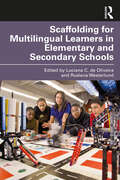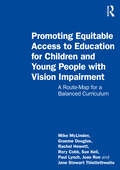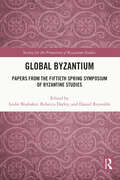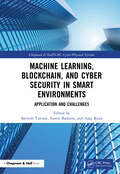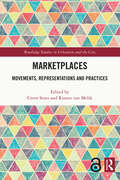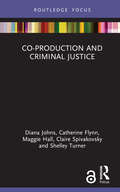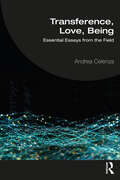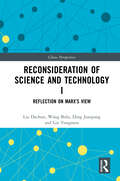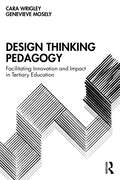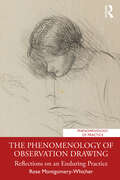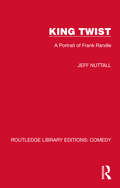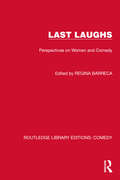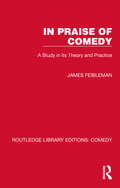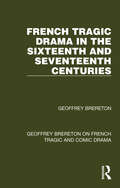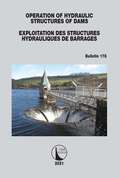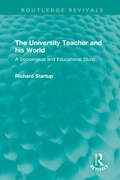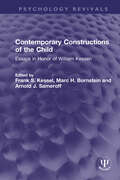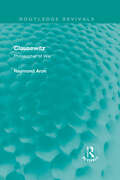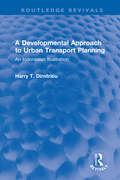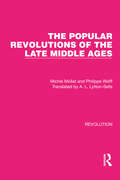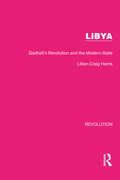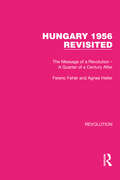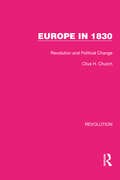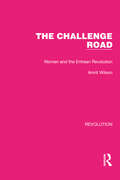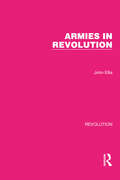Special Collections
Benetech’s Global Certified Accessible Titles
Description: Benetech’s GCA program is the first independent third-party EPUB certification to verify ebook accessibility. By creating content that is born accessible, publishers can meet the needs of all readers. Learn more: https://bornaccessible.benetech.org/
- Table View
- List View
Scaffolding for Multilingual Learners in Elementary and Secondary Schools
by Luciana C. de Oliveira and Ruslana WesterlundThis insightful and timely volume addresses how scaffolding can be used to support multilingual learners to amplify their opportunities for learning. As a dynamic educational process, scaffolding facilitates responsive and adaptive teaching and learning; addresses students’ needs; increases student autonomy; and promotes adaptive, high-level learning without simplifying instruction. Section I covers the theoretical grounding and reconceptualizations of scaffolding. Section II offers concrete examples and case studies from varied classroom contexts. Section III provides a window into professional development to discuss the work of pre-service and in-service teachers, and how they develop their understandings and practices of teaching multilingual learners. Contributors address diverse topics, including translanguaging in the classroom, scaffolding as a tool for equitable teaching, virtual learning, as well learning in dual language and content area classrooms. Featuring examples from teacher education programs as well as principles for design of educative curriculum materials, this book is ideal for pre-service teachers and students in TESOL, applied linguistics, and language education.
Promoting Equitable Access to Education for Children and Young People with Vision Impairment
by Paul Lynch and Mike Mclinden and Rory Cobb and Joao Roe and Graeme Douglas and Rachel Hewett and Sue Keil and Jane Stewart ThistlethwaitePromoting Equitable Access to Education for Children and Young People with Vision Impairment offers a suitable vocabulary and developmental route map to examine the changing influences on promoting equitable access to education for learners with vision impairment in different contexts and settings, throughout a given educational pathway. Bringing together a wide range of perspectives, this book argues that inclusive educational systems and teaching approaches should focus upon promoting and sustaining a balanced curriculum. It provides an analysis of how a suitable curriculum balance can be promoted and sustained through the stages of a given educational pathway to ensure equitable access and progression for all learners with vision impairment. The authors draw on the United Kingdom as a country study to illustrate the complex ecosystem within which learners with vision impairment are educated. Structured around a framework which provides a conceptually coherent and practical balance between universal and specialist approaches, this book is a relevant read for educators, academics, and researchers involved in vision impairment education as well as officials in government and non-government organisations engaged in developing education policy relating to inclusive education and disability.
Global Byzantium
by Daniel Reynolds and Leslie Brubaker and Rebecca DarleyGlobal Byzantium is, in part, a recasting and expansion of the old ‘Byzantium and its neighbours’ theme with, however, a methodological twist away from the resolutely political and toward the cultural and economic. A second thing that Global Byzantium – as a concept – explicitly endorses is comparative methodology. Global Byzantium needs also to address three further issues: cultural capital, the importance of the local, and the empire’s strategic geographical location. Cultural capital: in past decades it was fashionable to define Byzantium as culturally superior to western Christian Europe, and Byzantine influence was a key concept, especially in art historical circles. This concept has been increasingly criticised, and what we now see emerging is a comparative methodology that relies on the concept of ‘competitive sharing’, not blind copying but rather competitive appropriation. The importance of the local is equally critical. We need to talk more about what the Byzantines saw when they ‘looked out’, and what others saw in Byzantium when they ‘looked in’ and to think about how that impacted on our, very post-modern, concepts of globalism. Finally, we need to think about the empire’s strategic geographical position: between the fourth and the thirteenth centuries, if anyone was travelling internationally, they had to travel across (or along the coasts of) the Byzantine Empire. Byzantium was thus a crucial intermediary, for good or for ill, between Europe, Africa, and Asia – effectively, the glue that held the Christian world together, and it was also a critical transit point between the various Islamic polities and the Christian world.
Machine Learning, Blockchain, and Cyber Security in Smart Environments
by Ajay Rana and Sarvesh Tanwar and Sumit BadotraMachine Learning, Cyber Security, and Blockchain in Smart Environment: Application and Challenges provides far-reaching insights into the recent techniques forming the backbone of smart environments, and addresses the vulnerabilities that give rise to the challenges in real-word implementation. The book focuses on the benefits related to the emerging applications such as machine learning, blockchain and cyber security. Key Features: • Introduces the latest trends in the fields of machine learning, blockchain and cyber security • Discusses the fundamentals, challenges and architectural overviews with concepts • Explores recent advancements in machine learning, blockchain, and cyber security • Examines recent trends in emerging technologies This book is primarily aimed at graduates, researchers, and professionals working in the areas of machine learning, blockchain, and cyber security.
Marketplaces
by Rianne Van Melik and Ceren SezerThis edited volume portrays marketplaces from a mobility perspective as dynamic and open entities consisting of flows of people, goods and ideas. There is a renewed interest in research and policy arenas in marketplaces as the core of cities’ spatial and economic development and sociocultural life, as incubators of urban renewal and platforms of alternative consumption models and as source of livelihood for many people worldwide. Contributions of this book draw on notions of movements, representations and practices to illustrate that markets have physical reality but are also culturally and socially encoded, and experienced through practice. It brings together empirically evidenced scholarly and practice-based works from the United Kingdom, the Netherlands, Switzerland, Spain, Bulgaria, Turkey, Lebanon, Peru, Brazil, Vietnam, South Africa and India. This book is primarily intended for scholars and graduate students of urban geography, urban design and planning, sociology, anthropology, who are interested in the relation between place and mobility in general, and markets as ‘knots’ in the city, in particular. It also informs policy-makers how urban planning policies and design interventions for marketplaces may foster more socially inclusive and environmentally just cities.
Co-production and Criminal Justice
by Maggie Hall and Claire Spivakovsky and Catherine Flynn and Diana Johns and Shelley TurnerThis book explores practical examples of co-production in criminal justice research and practice. Through a series of seven case studies, the authors examine what people do when they co-produce knowledge in criminal justice contexts: in prisons and youth detention centres; with criminalised women; from practitioners’ perspectives; and with First Nations communities. Co-production holds a promise: that people whose lives are entangled in the criminal justice system can be valued as participants and partners, helping to shape how the system works. But how realistic is it to imagine criminal justice "service users" participating, partnering, and sharing genuine decision-making power with those explicitly holding power over them? Taking a sophisticated yet accessible theoretical approach, the authors consider issues of power, hierarchy, and different ways of knowing to understand the perils and possibilities of co-production under the shadow of "justice". In exploring these complexities, this book brings cautious optimism to co-production partners and project leaders. The book provides a foundational text for scholars and practitioners seeking to apply co-production principles in their research and practice. With stories from Australia, the United Kingdom, and Ireland, the text will appeal to the international community. For students of criminology and social work, the book’s critical insights will enhance their work in the field.
Transference, Love, Being
by Andrea CelenzaThrough a series of expansive essays, Transference, Love, Being explores the centrality of love in psychoanalytic practice. Starting with the immersion of the analyst, this book reimagines several aspects of the psychoanalytic process, including transference, countertransference, boundaries, embodiment, subjectivity and eroticism. To love is to cultivate to be. Psychoanalysis, as essentially vitalizing, is a playspace for taboo subjects within clear and safe parameters. Interweaving loving, being and perceiving, this book provides challenging new perspectives on the analysts's subjectivity, receptivity and its immersive influence on the analytic process. These essays refine theoretical understandings of the irreducible and omnipresent nature of love in psychoanalysis, thereby offering clarity to psychoanalysts, psychodyanmic therapists and scholars through the often-prohibited love and eroticism, here viewed as indispensible psychoanalytic theory and practice.
Reconsideration of Science and Technology I
by Liu Dachun and Wang Bolu and Ding Junqiang and Liu YongmouThis volume analyzes Karl Marx’s understanding of science and technology and how it is associated with his focus on the perspective of history and human practice, seeking to illuminate a renewed understanding of science and technology from a Marxist angle. As the first volume of a three-volume set that proposes to reconsider science and technology and explores how the philosophy of science and technology responds to an ever-changing world, the book delves into Marx’s analysis of scientific and technological problems and phenomena across five chapters. The authors explain the positioning of science and technology and the Marxist theoretical perspective of history and practice from which Marx’s views on science and technology derive before an examination of three focal dimensions pertaining to science and technology: productivity, technological alienation and liberty. Not always viewed as central to Marx’s works, discussions on science and technology are often underdeveloped – but a reinterpretation of Marx’s thoughts on the issues corroborates the efficacy of Marxism in terms of understanding today’s world and especially the development of science and technology. The volume will appeal to scholars and students interested in Marxist philosophy, the philosophy of science and technology and topics related to scientific culture.
Design Thinking Pedagogy
by Cara Wrigley and Genevieve MoselyThe problems facing society today are complex, multifaceted, and require crossing multiple disciplinary boundaries. As such, these problems call for interdisciplinary collaboration, including new and different combinations of skills and knowledge. Currently, tertiary education providers are not well-positioned to develop these interdisciplinary capabilities at a rate commensurate with the speed of contemporary change. This book places design thinking as the catalyst to create change in the tertiary education sector and to build interdisciplinary skill sets that are required for the graduate of the future. By presenting a series of case studies and drawing on global experts in the field, this book investigates pedagogical approaches, disciplinary facilitation practice, curriculum integration, and a framework for understanding design thinking pedagogy within tertiary education. Focusing on how educational institutions can produce innovative graduates with the ability to traverse disciplinary constraints, this book will be essential reading for research students, academics, and industry practitioners.
The Phenomenology of Observation Drawing
by Rose Montgomery-WhicherBased on research, and grounded in experience, this book offers a view into the minds and hearts of people who draw. With technology at our fingertips that allows us to record and share what we see within moments, drawing seems a remarkably slow and difficult way to make an image. And yet, drawing from observation continues to be practiced by professional and amateur artists, a situation that invites the question: What does observation drawing mean in the lives of those who practice it? The central chapters of the book explicate the structures of the lived experience of drawing, weaving phenomenological reflections into a narrative about the author drawing her sister on a train. With lively accounts of drawing from hobbyists, art students, contemporary and historical artists, Montgomery-Whicher considers how the act of drawing shapes place, time, the body and relationships with the world and with others. She addresses many facets of drawing, including the connection between drawing and thinking, the range of emotions felt when drawing a person and the experience of digital drawing. Montgomery-Whicher concludes that observation drawing warrants a place in general education as well as in the education of artists. She argues that drawing will continue to thrive because it is a human practice that deepens and enriches our humanity by giving us access to keener perception, greater understanding, empathy and wonder. This book will be of interest to anyone who has ever wondered about the appeal of drawing, including professional and amateur artists, philosophers, and educators.
King Twist
by Jeff NuttallBorn in Wigan in 1901 and a childhood friend of George Formby, who was later to become his chief rival, Frank Randle was one of the greatest music-hall comedians of all time. His theatre career started in 1916, when he appeared as an acrobatic artist under the name of Arthur Twist. It was not until the thirties, however, that he achieved his greatest popularity and notoriety as a comedian whose wild, manic temperament introduced a fresh note of invention into popular entertainment. For ten years he ran his own touring company, Randle’s Scandals, playing to enthusiastic audiences all over the country. He also made a number of shoe-string movies and was the star of Blackpool’s most distinguished summer-season show. During the early fifties his health declined and he died in Blackpool in 1957. Originally published in 1978, Jeff Nuttall’s account of Frank Randle is both a portrait of a ‘very, very, funny man’ and the story of his own search as he pieced that portrait together by talking to Randle’s acquaintances, friends, colleagues and relations. What emerges from his narrative is a beautifully recorded analysis of the ways in which working-class values are expressed in popular entertainment and are thus ritualised by it. The image Nuttall builds of Randle also allows him to explore the perennial theme of the clown as outsider and, with the passing of Randle, he acknowledges the passing of a certain naïve optimism which Randle so expressively embodied.
Last Laughs
by Regina BarrecaFirst published in 1988, the 19 original essays (and three "Sylvia" cartoons) included in this volume deal with the gender-specific nature of comedy. This pioneering collection observes the creation of women’s comedy from a wide range of standpoints: political, sociological, psychoanalytical, linguistic, and historical. The writers explore the role of women’s comedy in familiar and unfamiliar territory, from Austen to Weldon, from Behn to Wasserstein. The questions they raise will lead to a redefinition of the genre itself.
In Praise of Comedy
by James FeiblemanFirst published in 1939, the original blurb reads: We have learned much lately concerning theories of laughter, yet laughter is only what we do about comedy. What is comedy itself? In this work the history of comic instances is combed in the search for the truth about comedy. Today, when laughter is stifled in so many countries, an exposition of comedy shows it to have a universal and necessary character. Comedy, as its natures reveals, is one criterion of the state of human culture; it is highly contemporary and requires freedom – but freedom for adventure, not for routine. After a chapter devoted to the explanation of a logical theory of comedy, the modern comedians are examined, and the humour of every one, from the Marx Brothers to surrealism, from Gertrude Stein to Mickey Mouse, from James Joyce to Charlie Chaplin, is shown to be a constant, inherent in the same set of unchanging conditions.
French Tragic Drama in the Sixteenth and Seventeenth Centuries
by Geoffrey BreretonOriginally published in 1973, the history of French tragedy and tragicomedy from their origins in the sixteenth century to the last years of Louis XIV’s reign is here surveyed in a single volume. Beginning with a brief account of the development of drama from the Middle Ages to the Renaissance, Dr Brereton examines the plays as types of drama, the circumstances in which they were produced and their reception by contemporaries. The traditionally great figures of Corneille and Racine are treated at some length, but their work is seen in perspective against the plays of their predecessors and of their own time. Garnier and Montchrestien are discussed, among others, as notable writers of Renaissance humanist tragedy. Sections are devoted to secondary but still important dramatists such as Mairet, Rotrou, Du Ryer, Tristan L’Hermite, Thomas Corneille and Quinault. A long chapter on Alexandre Hardy reviews the work of this neglected author and stresses his interest as a transitional link between the two centuries and as a vigorous pioneer of a type of drama which flourished for several decades after him concurrently with French ‘classical’ tragedy. The main currents of critical theory, social attitudes and stage history are described in their relation to the development of the drama. Well over a hundred plays are discussed or summarized; and the author has constantly referred back to the original material and has avoided an over-simplification of a vast subject which contains more exceptions and anomalies than has generally been recognized in the past. Chronological tables of the works of major dramatists, summaries of numerous plays and a bibliography containing modern editions of plays are included.
Operation of Hydraulic Structures of Dams / Exploitation des Structures Hydrauliques de Barrages
by Icold CigbThis bulletin 178, Operation of Hydraulic Structures of Dams, is an update of Bulletin 49A (1986), which was the second edition of Bulletin 49 (1984). The current update was prepared using developments and progress made in the last 30 years with operation equipment, staff building and training, and regulatory requirements. Bulletin 178 addresses the need for safe reservoir discharge under a variety of conditions, the dam operator’s staffing, evaluation (inspection) of the condition of operating equipment, and operation during unusual or extreme conditions. The operation during unusual or extreme conditions is generally focused on flood and the current abilities to predict significant precipitation events, monitor the flood approach and impact, and communicate and implement the actions needed for safe operation. An annex is provided with seven case studies that provide relevant histories for the subject matter. Ce Bulletin 178 est une mise à jour du Bulletin 49A (1986) qui était la deuxième édition du Bulletin 49 (1984). Cette mise à jour a été préparée en considérant les développements et les progrès réalisés au cours des 30 dernières années sur l’équipement d’exploitation, la constitution des équipes, la formation du personnel ainsi que les exigences réglementaires. Le bulletin traite de la nécessité d’un déversement sécuritaire du réservoir dans diverses conditions, de la dotation en personnel de l’exploitant du barrage, de l’évaluation (inspection) de l’état de l’équipement d’exploitation et de l’exploitation dans des conditions inhabituelles ou extrêmes. L’opération dans des conditions inhabituelles ou extrêmes est généralement axée sur les crues et la capacité actuelle de prévoir les précipitations importantes, afin de surveiller l’approche et l’impact des inondations, de communiquer avec le public pour mettre en œuvre les mesures nécessaires à une exploitation sécuritaire. Une annexe présente sept études de cas qui fournissent des antécédents pertinents pour le sujet.
The University Teacher and his World
by Richard StartupOriginally published in 1979, the aim of this work was to analyse the occupational role of the university teacher, with the help of data collected within a specific university institution. This involves examining both what is expected of university teachers and what they actually do, and accounting for the patterns which their activities exhibit. Since the university teacher's occupation is multi-faceted it is necessary to examine several areas of activity including teaching, research and 'external' professional activities, as well as a number of types of relationships in which lecturers are involved. Data is presented and interpreted from interviews with the staff of four selected departments of a British provincial university (classics, pure mathematics, civil engineering and psychology) and also from questionnaire surveys of staff and students. Sociologically the university may be regarded as an organisation or institution, and the behaviour of its members understood through the notion of 'social role'. On the educational side of the study the central concern is with the teacher-pupil relationship. We are also confronted with a basic human problem of how employed people weave elements to give meaning to their working lives.
Contemporary Constructions of the Child
by Frank S. Kessel, Marc H. Bornstein and Arnold J. SameroffOriginally published in 1991, this volume contains critical state-of-the-art essays on significant aspects of children's development and developmental inquiry. Among the topics examined: infant perception, action and social cognition; concept development and language; children's play; parent education; children with autism and Tourette’s Syndrome; pediatrics and child development; and science, practice, and gender roles in early child psychology. A distinctive unifying theme arises from the contributors’ discussions of substantive ideas in the context of their own impressive intellectual biographies. While providing a collective case-study in the recent history of ideas, the contributors honor the intellectual and personal influence of William Kessen.
Clausewitz
by Raymond AronIn this edition, originally published in 1983, the late Professor Raymond Aron, one of France’s most distinguished social scientists, presented a major re-evaluation of Carl von Clausewitz, ‘the genius of war’. He sees in Clausewitz a political philosopher of major importance, whose impact and significance permeate many facets of modern society. Yet Clausewitz’s reputation was entirely posthumous, for his great work, On War, was published after his death, and in his lifetime he achieved only a limited reputation as a military thinker and planner. Even today he is more often quoted than closely read. Aron begins by elucidating the complexity of Clausewitz’s thought and by describing his main ideas. He gives an account of the successive phases in the development of On War, and traces the different interpretations of Clausewitz’s doctrine in Germany, in France and in Soviet Russia. Finally, Aron analyses many aspects of the present world using the concepts of Clausewitz, and is therefore able to examine such modern phenomena as the theory of the nuclear deterrent and ‘total war’ in Clausewitzian terms. This is a book of piercing insights by a writer of world-wide reputation, who used the Clausewitz world-view as a means of political analysis. It is thus still of great importance and interest to contemporary historians and to all who are concerned with military and political affairs.
A Developmental Approach to Urban Transport Planning
by Harry T. DimitriouOriginally published in 1995, this monograph examines a developmental approach to urban transport planning, with reference to Indonesia. It provides a profile of the country, outlining Indonesia’s geography and population, historical and political background, economic profile and constraints on development. Recent trends in Indonesian development are outlined. Indonesian urban transport demand and supply are analysed, and policy and planning frameworks for urban transport set out, including national policy and financial and institutional issues. Factors affecting urban transport are considered such as settlement characteristics and matching of transport systems with settlement hierarchy. The applicability of a developmental approach to urban transport planning for Indonesia is analysed with reference to experience in industrialized nations and the Third World.
The Popular Revolutions of the Late Middle Ages
by Michel Mollat and Philippe WolffThis book, first published in 1973, examines the period when wars, famines and epidemics bred widespread conflicts, culminating in the revolutionary years of 1378–82 with the Florentine ‘Ciompi’, revolts in Flanders and France and the risings among English labourers. The analysis ends with the Hussite crisis which gave the movement a new aspect. The troubles were varied, with hunger riots in cities and brigandage in the country, open struggles between lords and peasants, urban conflicts over municipal power, and labour conflicts over pay and hours.
Libya
by Lillian Craig HarrisThis book, first published in 1986, provides a comprehensive look at the social, cultural, political and economic forces that shaped Libya following the 1969 revolution. Libya’s political system under Qadhafi’s Third Universal Theory is examined, as are the power structures – military, tribal, economic and religious.
Hungary 1956 Revisited
by Agnes Heller and Ferenc FehérThis book, first published in 1983, is a radical reinterpretation of the Hungarian revolution in the context of world politics and Eastern Europe as a whole. It examines the events and protagonists with a fresh eye, and relies on witnesses and participants for the rigorous documentary backing.
Europe in 1830
by Clive H. ChurchThis book, first published in 1983, is a valuable corrective to the lack of academic research on the events of 1830 – a year of revolutions across the continent of Europe. Social protests and political changes are examined to note the causes of the political turmoil and revolution in 1830, and then the results of the revolutions’ developments are analysed, as general European social, political and diplomatic crises as well as a series of individual outbreaks. The book also turns to comparative study to look at the hows and wherefores of the revolutions, as the dynamics, participants and effects of revolution are examined in turn.
The Challenge Road
by Amrit WilsonThis book, first published in 1991, analyses the role of women in the Eritrean struggle for independence. Emerging from a semi-feudal world, these women – peasants and pastoralists, student activists and workers from the cities – participated fully in the Eritrean revolution. They have organized cells, gathered intelligence, carried out clandestine missions, set up and ran health and education systems and fought on the front line, and in transforming themselves they have transformed Eritrea.
Armies in Revolution
by John EllisThis book, first published in 1973, examines seven revolutionary armies ranging from Cromwell’s New Model Army to the Red Army of Mao Zedong. In each case it examines the mobilisation and organisation of the army, and the need to balance political ideals and aspirations with military cohesion and discipline, and social stability. This book is an outstanding example of a study of the relationship between the military and society, and shows that no revolution can succeed without an organised army and that few such armies can tolerate for long the ideology that created them.
